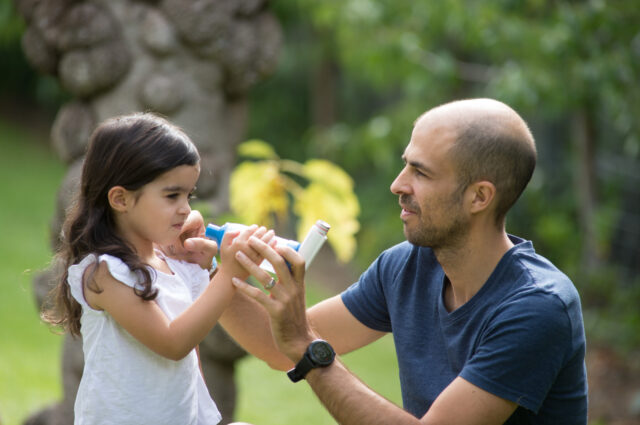Australian Asthma Handbook
The National Guidelines for Health Professionals
Cite
Table
| Good control | Poor control |
Daytime symptoms (e.g. wheeze, difficult breathing, cough) ≤2 days per week Need for salbutamol ≤2 days per week* Symptoms last only a few minutes and are rapidly relieved by salbutamol No limitation of activities due to asthma No symptoms during night or when wakes up (including no coughing during sleep) | Daytime symptoms (e.g. wheeze, difficult breathing, cough) >2 days per week Need for salbutamol >2 days per week* Any limitation of activities due to asthma Any symptoms at night (including coughing during sleep) Waking with wheezing or breathing problems |
Additional information
*Do not include doses given before exercise
Table
| Assess or recheck: | Sample questions for parent/carer (modify/select as relevant) |
| 1. Exacerbation history | Has child had a flare-up since last visit? If yes, what triggered it? (e.g. cold symptoms, allergies, stopping preventer) How was the flare-up treated? Has child since last visit/ever needed to take oral corticosteroids? (How often and how much?) Has child ever been hospitalised for asthma or a wheezing episode? When was the child’s last flare-up (and last flare-up before that one)? How were these flare-ups treated? How many times has child visited GP/hospital emergency room for asthma symptoms in the last [specify time period, e.g. year/month/2 weeks]? |
| 2. Allergies | Does child have allergic rhinitis (hay fever)? Is child using other medicines for respiratory symptoms (e.g. oral or intranasal antihistamines, intranasal corticosteroids)? Is exposure to the known allergen avoidable? Does the child have allergies (e.g. to foods or insect bites) or need an adrenaline injector (e.g. Epipen) for emergencies? Does the child get skin rashes caused by allergies? |
| 3. Inhaler technique | Can you show me how you use the inhaler? When did you last wash the spacer? (How do you wash it?) |
Table
High probability of respiratory viral infection (beginning of day care/preschool term, epidemics) Confirmed food allergy or history of anaphylaxis Poor asthma symptom control ED visit or admission to hospital for asthma in preceding 12 months History of sudden, unpredictable exacerbations not preceded by gradual worsening of symptoms History of intubation/paediatric ICU admission for acute asthma Over-use of salbutamol Poor adherence to prescribed ICS treatment by parents/carers Poor inhaler technique for ICS Frequent failure to attend consultations Parent’s/carer’s inability to follow asthma action plan Significant parental psychological or socioeconomic problems Carer unequipped to manage asthma emergency Exposure to clinically relevant allergens Exposure to tobacco smoke Damp housing Exposure to outdoor pollution Obesity High eosinophil count (if known) |
How often does child wheeze or become breathless?
Does child wake during the night due to wheezing or breathing problems? (How many times per month?)
How often does child need to take reliever inhaler? (How many days per week? How many times per day? How many puffs?)
How many weeks does child’s reliever inhaler last?
Has child missed time from childcare, preschool or activities due to asthma?
Recommendation type: Consensus recommendation
Asthma symptoms are well controlled if the child has daytime symptoms (e.g. wheeze, difficult breathing, cough) on no more than 2 days per week and uses salbutamol on no more than 2 days per week (not counting prophylactic doses before exercise), symptoms are rapidly relieved by salbutamol, asthma does not limit activity, and the child never has symptoms during the night or on waking (including no coughing during sleep).
Also ask about exacerbations, which can occur even in children who typically do not have symptoms between exacerbations.
Ask whether anything in particular seems to cause the symptoms (e.g. respiratory viruses, physical activity, allergies, smoke from fires, fumes).
Ask if child is sometimes near people who are smoking, or sometimes spends time in a room or car where someone has been smoking.
Ask about exposure to indoor damp or moulds and other indoor/outdoor air pollution.
Recommendation type: Consensus recommendation
Information on triggers for asthma symptoms and exacerbations
Recommendation type: Consensus recommendation
It is not possible to predict the risk of severe exacerbations accurately in individual children, but several population-level risk factors have been identified.[Navanandan 2021]
Approximately 85% of severe asthma exacerbations in children are caused by airway inflammation following infection with respiratory viruses such as human rhinovirus, respiratory syncytial virus, parainfluenza virus, and influenza viruses.[Puranik 2017] An individual child’s risk might be predicted from seasonal infection patterns and day care or preschool terms. In school-aged children, allergic sensitisation has been reported to increase the risk of severe asthma exacerbations after viral illnesses (particularly rhinovirus C).[Puranik 2017]
A history of asthma exacerbations requiring urgent care, ED visits, hospitalisation is associated with increased risk of future asthma exacerbations in children.[Puranik 2017] A severe exacerbation in the previous year is the strongest individual predictor of a future severe exacerbation in children.[Navanandan 2021]
Exposure to cigarette smoke is associated with worsening lung function, reduced response to asthma treatment, and ED visits for asthma.[Puranik 2017] Salivary cotinine levels, detecting recent exposure to tobacco smoke, has been shown to predict asthma exacerbations in children aged 8–14 years.[Puranik 2017]
Other environmental exposures that increase exacerbation risk include outdoor air pollution, damp housing, and allergens for sensitised children.[Puranik 2017]
In children ≥ 6 years, extreme obesity has been associated with increased risk of an asthma exacerbation within the following 12 months, compared with children of normal weight.[Puranik 2017]
Increased levels of inflammatory biomarkers such as eosinophil count and FeNO are associated with increased risk of exacerbations,[Navanandan 2021] but these are not recommended for routine monitoring of asthma in preschool children.
Other risk factors for exacerbations include demographic characteristics such as family low income and family ethnocultural minority group status.[Navanandan 2021]
Navanandan N, Hatoun J, Celedón JC, et al. Predicting severe asthma exacerbations in children: blueprint for today and tomorrow. J Allergy Clin Immunol Pract 2021; 9: 2619-2626.
Puranik S, Forno E, Bush A, et al. Predicting severe asthma exacerbations in children. Am J Respir Crit Care Med 2017; 195: 854-859.
Testing for allergic triggers (skin-prick test or blood test for specific IgE) may be useful to identify triggers. Results should be interpreted according to clinical findings.
Information on asthma triggers
Perform or arrange spirometry:
Recommendation type: Consensus
Poor lung function may remain detected if spirometry is not conducted.
Tools validated for use in school-aged children include Childhood Asthma Control Test (CACT) – suitable for children aged 4–11 years.
Recommendation type: Consensus recommendation
The Childhood Asthma Control Test (C-ACT) is validated in children aged 4–11 years.[Murphy 2009]
Liu AH, Zeiger R, Sorkness C, et al. Development and cross-sectional validation of the Childhood Asthma Control Test. J Allergy Clin Immunol 2007; 119: 817-825.
Asthma assessment tools
At least once each year, measure height and weight, accurately measured and plotted on a percentile chart.
Recommendation type: Consensus recommendation
Maintenance ICS treatment in children is associated with a dose-dependent reduction in growth velocity.[Axelsson 2019]
Uncontrolled asthma also reduces children’s growth and final adult height.[Pedersen 2001]
Axelsson I, Naumburg E, Prietsch SO, Zhang L. Inhaled corticosteroids in children with persistent asthma: effects of different drugs and delivery devices on growth. Cochrane Database Syst Rev 2019; 6: CD010126.
Pedersen S. Do inhaled corticosteroids inhibit growth in children? Am J Respir Crit Care Med 2001; 164: 521-35.

Medication management
How to step up or step down asthma treatment for a child aged 6–11 years, to maintain symptom control, prevent…

Principles of management
How to administer inhaled medicines to children.

Principles of management
How to equip and coach children and their parents to manage childhood asthma, including exacerbations.